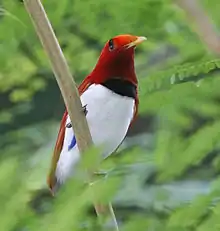King bird-of-paradise
The king bird-of-paradise (Cicinnurus regius) is a passerine bird of the Paradisaeidae (Bird-of-paradise) family. It is a member of the genus Cicinnurus.[2]
| King bird-of-paradise | |
|---|---|
 | |
| Male | |
| Scientific classification | |
| Kingdom: | Animalia |
| Phylum: | Chordata |
| Class: | Aves |
| Order: | Passeriformes |
| Family: | Paradisaeidae |
| Genus: | Cicinnurus Vieillot, 1816 |
| Species: | C. regius |
| Binomial name | |
| Cicinnurus regius | |
| Synonyms | |
|
Paradisaea regia Linnaeus, 1758 | |
The king bird-of-paradise is a common and wide-ranging species, distributed throughout lowland forests of New Guinea and western satellite islands. Some populations range quite high into the hills and lower mountains, and these are poorly known as yet.[3]
The first captive breeding of this species was by Dr. Sten Bergman of Sweden in 1958. He was awarded a commemorative medal by the Foreign Bird League to mark this achievement.
Subspecies
- C. r. coccineifrons
- C. r. cryptorhynchus
- C. r. gymnorhynchus
- C. r. regius
- C. r. rex
- C. r. similis
Description
This so-called "living gem"[4] is the smallest and most vividly colored among birds-of-paradise.
The king bird-of-paradise is small, measuring approximately 6.3–7.5 inches (16–19 cm) long, but 12.2 inches (31 cm) if central rectrices of adult males included.[5] Females weight about 0.08–0.13 pounds (36–59 g), males 0.10–0.14 pounds (45–64 g).[5]
The adult male has a overall metallic crimson color, slightly orange under certain lights,[6] and more particularly so in the crown. They have a narrow, dark green iridescent breast band with whitish lower breast, and green-tipped fan-like plumes on shoulder.[5] The feathers of the undertail and mantle are olive-brown, with iridescent green tips, and violet legs.[5] Bills are ivory-yellow. Females have dull olive head and upperparts with yellowish underparts and violet legs.[7]
Distribution and habitat
The King Bird-of-paradise is distributed throughout the majority of lowland New Guinea mainland, and on the surrounding islands, including Aru, Salawati, Missol, and Yapen, inhabiting mostly lowland rainforests, gallery forests, forest edges, and disturbed and tall secondary forests.
- Cicinnurus regius [regius, rex or gymnorhynchus]: S New Guinea, Aru and w Papuan islands
- Cicinnurus regius [coccineifrons, similis or cryptorhynchus]: N watershed of main body of New Guinea and Yapen I.
Ecology and behaviour
There is little information available about this species’ behavior. They are inconspicuous and may be hard to locate,[3] except for males at their display trees.[7]
Courtship and breeding
The species is polygynous, with the promiscuous adult males displaying in isolation at exploded leks and in groups at traditional arboreal courts.[8] They are perhaps more persistent callers than any other birds of paradise. Courtship involves complex vocalizations, feather manipulations, and a variety of body posturing and movements, including hanging fully inverted and pendulum-like swinging.[7] An extraordinary courtship display is performed by the male with a series of tail swinging, fluffing of the white abdominal feathers that makes the bird look like a cottonball, and acrobatic movements of their elongated tail wires.
Breeding occurs at least during March through October. The open cup nest is built into a tree cavity (unique within family), within which two eggs are laid. Female builds the nest and cares for the young without male assistance. In captivity, incubation lasted 17 days and the nestling period was 14 days.[7]
Feeding and diet
The diet consists mainly of fruits and arthropods. Foraging occurs at all forest levels, where birds often join mixed species foraging flocks to seek arthropods in the lower forest.[7]
Conservation status
The species is tentatively assessed as being in decline due to habitat loss[9] and unsustainable levels of hunting. However, despite the fact that the population trend appears to be decreasing, being a widespread and a abundant species throughout their large habitat range, the king bird-of-paradise is evaluated as Least Concern on the IUCN Red List of Threatened Species.[10] It is listed on Appendix II of CITES.
References
- BirdLife International (2012). "Cicinnurus regius". IUCN Red List of Threatened Species. 2012. Retrieved 26 November 2013.CS1 maint: ref=harv (link)
- "Crows, mudnesters & birds-of-paradise". IOC World Bird List. International Ornithological Committee. Retrieved 5 August 2017.
- Gregory, Phill (2020). Birds of Paradise and Bowerbirds. Bloomsbury Publishing. ISBN 9781472975843.
- Designing Social Interfaces: Principles, Patterns, and Practices for Improving the User Experience by Christian Crumlish and Erin Malone (17 September 2009)
- Pratt, Thane K. (26 October 2014). Birds of New Guinea. Beehler, Bruce McP,, Bishop, K. David,, Coates, Brian J.,, Diamond, Jared M.,, Lecroy, Mary,, Anderton, John (Second ed.). Princeton, New Jersey. ISBN 978-1-4008-6511-6. OCLC 894139572.
- British Museum (Natural History) (1877). Catalogue of the birds in the British Museum. 3. London: British Museum (Natural History). Department of Zoology. pp. 171–172. OCLC 220992160.
- A. Jackson, Jerome; Bock, Walter J.; Olendorf, Donna, eds. (2002). Grzimek's Animal Life Encyclopedia, 2nd Edition. 11. Farmington Hills, MI: Gale Group, 2002. pp. 499–500. ISBN 0-7876-5787-5.
- News. "King Bird of Paradise". The Australian Museum. ABN 85 407 224 698. Retrieved 2020-09-22.
- Tracewski, Łukasz; Butchart, Stuart H.M.; Di Marco, Moreno; Ficetola, Gentile F.; Rondinini, Carlo; Symes, Andy; Wheatley, Hannah; Beresford, Alison E.; Buchanan, Graeme M. (October 2016). "Toward quantification of the impact of 21st-century deforestation on the extinction risk of terrestrial vertebrates: Effects of Deforestation on Vertebrates". Conservation Biology. 30 (5): 1070–1079. doi:10.1111/cobi.12715. PMID 26991445.
- International), BirdLife International (BirdLife (2018-08-06). "IUCN Red List of Threatened Species: Cicinnurus regius". IUCN Red List of Threatened Species. doi:10.2305/iucn.uk.2018-2.rlts.t22706208a130412002.en. Retrieved 2020-09-22.
External links
| Wikimedia Commons has media related to Cicinnurus regius. |
| Wikispecies has information related to Cicinnurus regius. |
- BirdLife Species Factsheet
- King Bird-of-Paradise, courtship display at YouTube, by Cornell Lab of Ornithology
